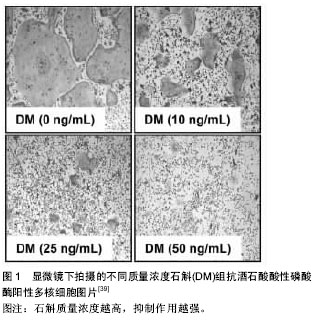| [1] 钱兴皋,刘宇恒,王琴,等.炎症因子对骨质疏松症发病影响的研究进展[J].中国康复理论与实践,2013,19(7):645-646.[2] 夏婷,李双庆.炎症相关骨质疏松症的发病机制[J].中国骨质疏松杂志,2015,21(1):117-120.[3] 杜艳萍,程群.炎症在骨质疏松发生中的作用与机制研究新进展[J].老年医学与保健,2013,19(6):427-431.[4] 王凌.骨质疏松症的炎症机制[C].全国中西医结合生殖系统炎症性疾病专题学术会议论文集,贵阳:2013:43-50.[5] 邹世恩,张绍芬.细胞因子在绝经后骨质疏松症发病机制中的作用[J].中国骨质疏松杂志,2012,18(4):375-380.[6] 刘连勇,郑胜喜,甄燕,等. 原发性骨质疏松症的骨骼免疫机制研究进展[J]. 中国骨质疏松杂志,2016,22(7):912-917.[7] 常志芳,冯成龙,史晓霞,等. 免疫与骨质疏松的研究进展[J].中国骨质疏松杂志,2015,21(4):508-513.[8] 欧国峰,刘鑫,董博,等.绝经后骨质疏松症的免疫学研究进展[J].中医正骨,2016,28(8):70-72.[9] 李文艳,徐玉善,李红.免疫调节在骨质疏松症中的研究进展[J].医学综述,2015,21(2):213-216.[10] 章岚,陈勇.慢性持续性低度炎症与运动、健康和疾病的研究进展[J].北京体育大学学报,2014,37(8):71-76.[11] 叶翎,孙国燕,孙玉瑶,等.慢性低度炎症与糖尿病关系的研究进展[J].医学综述,2014,20(21):3846-3848.[12] Robinson WH, Lepus CM, Wang Q,et al.Low-grade inflammation as a key mediator of the pathogenesis of osteoarthritis.Nat Rev Rheumatol.2016 10;12(10):580-592.[13] Chronic Disease; Controlling inflammation to reduce chronic disease risk. Obesity & Diabetes Week 2015 Aug 24:6.[14] Erbas O,Akseki H,Aktu H,et al.Low-grade chronic inflammation induces behavioral stereotypy in rats. Metab Brain Dis 2015;30(3):739-746.[15] Frank MO, Caceres BA. Inflammaging: A Concept Analysis. The Journal for Nurse Practitioners.2015;11(2):258-261.[16] Ilich JZ, Kelly OJ, Kim Y, et al. Low-grade chronic inflammation perpetuated by modern diet as a promoter of obesity and osteoporosis.ArhHig Rada Toksikol. 2014; 65(2):139-148.[17] Wärnberg J, Cunningham K, Romeo J,et al. Physical activity, exercise and low-grade systemic inflammation. Proc Nutr Soc. 2010;69(3):400-406.[18] Kolb H, Mandrup-poulsen T.The global diabetes epidemic as a consequence of lifestyle-induced low-grade inflammation. Diabetologia.2010;53(1):10-20.[19] Costello-white R, Ryff CD, Coe CL. Aging and low-grade inflammation reduce renal function in middle-aged and older adults in Japan and the USA. Age (Dordr). 2015 ;37(4):9808.[20] Novack DV,Faccio R.Osteoclast motility: putting the brakes on bone resorption.Ageing Res Rev.2011;10(1):54-61. [21] Jabbar S,Drury J,Fordham JN,et al.Osteoprotegerin,RANKL and bone turnover in postmenopausal osteoporosis.J ClinPathol.2011;64( 4) : 354-357.[22] Trouvin AP, Goëb V.Receptor activator of nuclear factor-κB ligand and osteoprotegerin: maintaining the balance to prevent bone loss.ClinInterv Aging.2010;19(5): 345-354.[23] Blumenfeld O, Williams FM, Valdes A, et al.Association of interleukin-6 gene polymorphisms with hand osteoarthritis and hand osteoporosis.Cytokine.2014; 69:94-101.[24] Ivanova JT, Boyanov MA, Toshev AK. Polymorphisms of the human IL-1 receptor antagonist gene and forearm bone mineral density in postmenopausal women. Indian J EndocrMetab.2012; 16:580-584. [25] 常睿洁.骨质疏松症的中西药治疗进展[J].中国新药杂志,2015, 4(13):1498-1503.[26] 张燕燕,卢春燕,刘斌,等.骨质疏松症的药物治疗[J].中国骨质疏松杂志,2007,13(11):809-813.[27] van Staa TP, Leufkens HG, Cooper C. The epidemiology of corticosteroid-induced osteoporosis: a meta-analysis. OsteoporosInt.2002;13(10):777-787.[28] Boyle WJ,Simonet WS,Lacey DL.Osteoclast differentiation and activation.Nature. 2003;423(6937):337-342.[29] Suda T,Kobayashi K,Jimi E,et al.The molecularbasis of osteoclast differentiation and activation. Novartis Found Symp. 2001;232:235-247.[30] Wada T,Nakashima T,Hiroshi N,et al. RANKL-RANK signaling inosteoclastogenesis and bone disease. Trends Mol Med. 2006;12(1):17-25.[31] Takayanagi H, Kim S, Koga T,et al. Inductionand activation of the transcription factor NFATc1 (NFAT2) integrateRANKL signaling in terminal differentiation of osteoclasts. Dev Cell. 2002;3(6):889-901.[32] Rodan SB,Rodan GA.Integrin function in osteoclasts.J Endocrinol.1997;154(Suppl):S47-56.[33] Yagi M, Miyamoto T, Sawatani Y, et al.DC-STAMP is essential for cell-cell fusion in osteoclasts and foreign bodygiant cells. J Exp Med.2005;202(3):345-351.[34] Goto T,Yamaza T,Tanaka T.Cathepsins in the osteoclast.J Electron Microsc(Tokyo). 2003;52(6):551-558.[35] Suda K,Woo JT,Takami M,et al. Lipopolysaccharide supportssurvival and fusion of preosteoclasts independent of TNF-alpha, IL-1, andRANKL. J Cell Physiol. 2002;190(1): 101-108.[36] Sakuma Y, Tanaka K, Suda M,et al. Impaired boneresorption by lipopolysaccharide in vivo in mice deficient in theprostaglandin E receptor EP4 subtype. Infect Immun. 2000;68(12):6819-6825.[37] Orcel P, Feuga M, Bielakoff J, et al. Local bone injections of LPSand M-CSF increase bone resorption by different pathways in vivo in rats.Am J Physiol. 1993;264(3 Pt 1): E391-397.[38] Lee W,Eom DW,Jung Y,et al.Dendrobiummoniliforme attenuates high-fat diet-induced renal damage in mice through the regulation oflipid-induced oxidative stress. Am J Chin Med.2012;40:1217-1228. [39] Baek JM , Kim JY , Ahn SJ , et al. Dendrobium moniliforme Exerts Inhibitory Effects on Both Receptor Activator of Nuclear Factor Kappa-B Ligand-Mediated Osteoclast Differentiation in Vitro and Lipopolysaccharide-Induced Bone Erosion in Vivo.Molecules.2016;21(3):295.[40] Uddin MK, Juraimi AS, Hossain MS,et al. Purslane weed (Portulacaoleracea): a prospective plantsource of nutrition, omega-3 fatty acid, and antioxidant attributes. Scientific World J. 2014;2014:951019[41] Chan K, Islam MW, Kamil M,et al. The analgesic and anti-inflammatory effectsof Portulacaoleracea L. ssp. Sativa (HAW.)CELAK. J Ethnopharmacol. 2000;73(3):445-451.[42] Silva R, Carvalho IS.In vitro antioxidant activity, phenolic compoundsand protective effect against DNA damage provided byleaves, stems and flowers of Portulacaoleracea (PURSLANE). Nat Prod Commun. 2014;9(1):45-50.[43] Kim JY, Oh HM, Kwak SC, et al. Purslane suppresses osteoclast differentiation and bone resorbing activity via inhibition of Akt/GSK3β-c-Fos-NFATc1 signaling in vitro and prevents lipopolysaccharide-induced bone loss in vivo. Biol Pharm Bull. 2015;38(1):66-74. [44] Cao H, Zhu K, Qiu L,et al.Criticalrole of AKT protein in myeloma-induced osteoclast formation andosteolysis. J Biol Chem. 2013;288(42):30399-30410.[45] Moon JB, Kim JH, Kim K,et al.Aktinduces osteoclast differentiation through regulating the GSK3beta/NFATc1 signaling cascade. J Immunol. 2012;188(1):163-169.[46] Kim JY, Park SH, Oh HM, et al.Ampelopsisbrevipedunculata Extract Prevents Bone Loss byInhibiting Osteoclastogenesis in Vitro and in Vivo. Molecules. 2014;19(11):18465-18478. [47] Idris AI, Krishnan M, Simic P,et al.Small molecule inhibitors of IkappaB kinase signaling inhibit osteoclastformation in vitro and prevent ovariectomy-induced bone loss in vivo.FASEB J.2010;24(11):4545-4555.[48] Byun MW.Schizonepetatenuifolia ethanol extract exerts anti-inflammatoryactivity through the inhibition of TLR4 signaling in lipopolysaccharidestimulatedmacrophage cells.J Med Food.2014;17(3):350-356.[49] Wang BS,Huang GJ, Tai HM,et al. Antioxidant and anti-inflammatoryactivities of aqueous extracts of SchizonepetatenuifoliaBriq.Food ChemToxicol. 2012;50(3-4): 526-531.[50] Kim JY, Baek JM, Ahn SJ, et al.Ethanolic extract of Schizonepetatenuifoliaattenuates osteoclast formation and activation in vitro and protects againstlipopolysaccharide- induced bone loss in vivo. BMC Complement Altern Med. 2016;16(1):301.[51] Hadjidakis DJ,Androulakis II.Bone remodeling.Ann N Y Acad Sci.2006;1092:385–396.[52] Tanaka Y, Nakayamada S, Okada Y. Osteoblasts and osteoclasts in boneremodeling and inflammation. Curr Drug Targets Inflamm Allergy.2005;4(3):325-328. |
.jpg)
.jpg)


.jpg)
.jpg)